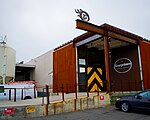Bartell Drugs
1890 establishments in Washington (state)2020 mergers and acquisitionsAmerican companies established in 1890Companies based in SeattleHealth care companies based in Washington (state) ... and 3 more
Pharmacies of the United StatesRetail companies established in 1890Rite Aid

The Bartell Drug Company, commonly known as Bartell Drugs and referred to by locals as simply "Bartell's", is a chain of pharmacies in the Puget Sound area of Washington state. Bartell Drug stores primarily serve the Seattle area. Bartell's was believed to be the nation's oldest existing family-owned drugstore chain until it was sold to Rite Aid in 2020.
Excerpt from the Wikipedia article Bartell Drugs (License: CC BY-SA 3.0, Authors, Images).Bartell Drugs
Utah Avenue South, Seattle Georgetown
Geographical coordinates (GPS) Address Nearby Places Show on map
Geographical coordinates (GPS)
| Latitude | Longitude |
|---|---|
| N 47.56135 ° | E -122.334755 ° |
Address
Utah Avenue South 4600
98134 Seattle, Georgetown
Washington, United States
Open on Google Maps







